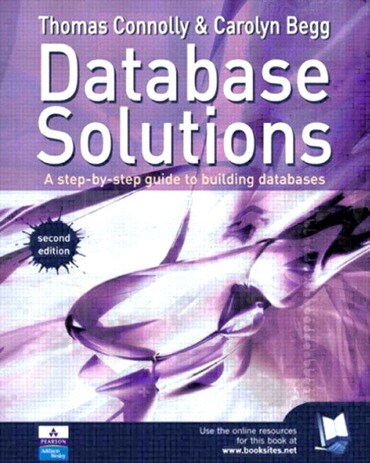
- Thomas Connolly |
- Carolyn Begg |
Title overview
Are you responsible for designing and creating the databases that keep your business running? Or are you studying for a module in database design? If so, Database Solutions is for you! This fully revised and updated edition will make the database design and build process smoother, quicker and more reliable.
Recipe for database success
- Take one RDMS – any of the major commercial products will do: Oracle, Informix, SQL Server, Access, Paradox
- Add one thorough reading of Database Solutions if you are an inexperienced database designer, or one recap of the methodology if you are an old hand
- Use the design and implementation frameworks to plan your timetable, use a common data model that fits your requirements and adapt as necessary
- Includes hints and tips for success with comprehensive guidance on avoiding pitfalls and traps.
- Shows how to create data models using the UML design notation.
- Includes two full-length coded example databases written on Microsoft Access 2002 and Oracle 9i, plus 15 sample data models to adapt to your needs, chosen from seven common business areas.
- New chapters on SQL (Structured Query Language) and QBE (Query by Example), plus a chapter on database administration and security. A new chapter on current and emerging trends in the area ensures that the book is up to date.
- The database design methodology has been improved and simplified.
- A companion website contains an implementation of the StayHome database that runs throughout the book, plus SQL scripts for 15 sample data models, lecture slides, sample solutions for all exercises from the book plus suggested exam questions and answers, and a variety of possible courseworks.
Table of contents
Part 1 Background
1 Introduction
2 The relational model
3 SQL and QBE
4 The database system development lifecycle
5 Database administration and security Part 2 Database analysis and design techniques
6 Fact-finding
7 Entity-Relationship modeling
8 Normalization Part 3 Logical database design
9 Logical database design - Step 1
10 Logical database design - Step 2
11 Enhanced ER modeling techniquesPart 4 Physical database design
12 Physical database design - Step 3
13 Physical database design - Step 4
14 Physical database design - Steps 5 and 6
15 Physical database design - Step 7
16 Physical database design - Step 8 Part 5 Second worked example
17 PerfectPets - Logical database design
18 PerfectPets - Physical database design Part 6 Current and emerging trends
19 Current and emerging trends Appendices
A Alternative data modeling notations
B Summary of the database design methodology
C Advanced logical database design
D File organizations and indexes
E Common data models Glossary References Index